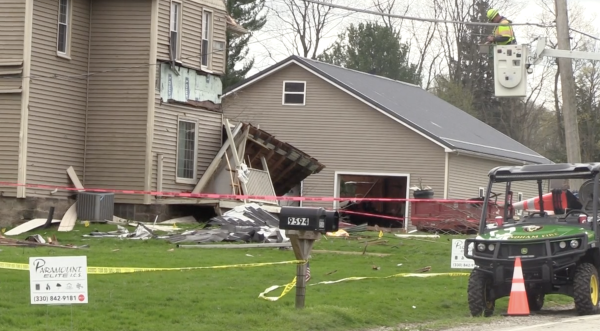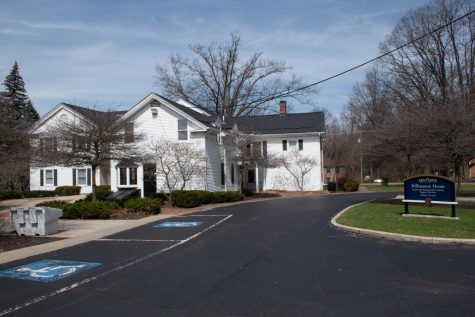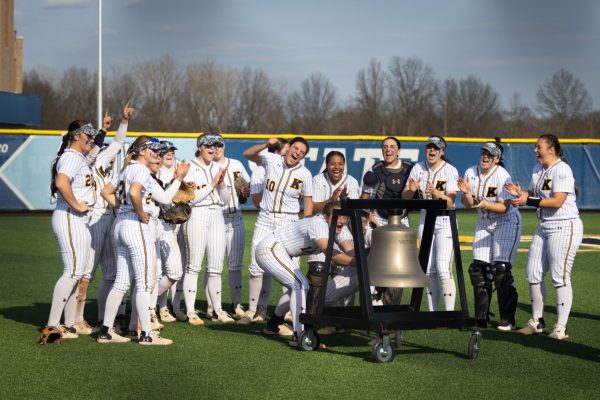An intoxicating hobby that isn’t all about the alcohol
April 23, 2007
Benjamin Wiford can drive half a mile to the Kent Acme to get a six-pack of beer.
Or, he can walk 800 feet to the Campus Wine Cellar.
Or, he can open his closet door and pull a few unlabeled brown bottles out of a cardboard box, toss them in the refrigerator for a couple hours and have a homemade brew.
Though Wiford, junior aeronautics major, may fall out of the target market for the hobby – retailers and distributors say the typical demographic is 35- to 60-year-olds in the upper-middle income bracket – he’s gotten in on something that’s becoming quite popular all around.
“The growth rate right now is phenomenal,” said Matt Pruszynski, owner of home brewing supplier America’s Hobby House, located at 4220 state Route 43 in Kent. Pruszynski’s hobby shop has been selling beer and wine making products for about four-and-a-half years.
While it’s no secret that a lot of beer comes into Kent, with the dozen or so bars that populate the area, what might not be so well known is that a lot of beer also starts out in Kent.
Located at 463 Portage Blvd. in Kent is LD Carlson, the largest home beer and wine making product distributor in the nation. Its 20,000-plus square foot warehouse holds everything from giant bags of barley to 44-pound bales of hops to fruit presses to the bottles and caps that hold the finished product.
Jason Hollister, purchasing agent for LD Carlson, said the company ships all over the East Coast and Midwest and has a few western accounts.
Hollister said the business has been growing consistently each year. To meet the increased demand, LD Carlson is adding a 16,000-square-foot warehouse addition this year, as well as an office expansion. Hollister expects the company to hire at least five new employees to go with the roughly 50 who currently work there.
A lifestyle thing
Pruszynski admitted that the involvement of alcohol is a major contributor to the popularity of the hobby, but he cautioned that isn’t what the hobby is about.
“It’s a lifestyle-type thing,” he said.
Pruszynski teaches a free beginner-level beer-making class each month. He makes sure to inform the students of the true reason for the hobby.
“When I’m teaching classes, I say ‘if you’re doing this to get drunk, go down the street and buy some cheap beer . that’s not the purpose of this hobby.'” Pruszynski said. “It’s more for the pride; the culture of sharing a glass of something you made with your spouse or somebody over dinner or over conversation.”
Wiford said he likes to see others enjoying his beer almost as much as he likes drinking it himself.
Pruszynski said it’s the norm for people to want to share their creation. “Everybody takes a bottle of wine or some home brew with them when they go somewhere when they’re in this hobby.”
Or, in his case, more than a bottle or two.
“I’m getting married this summer, and I’m making 30 batches of wine and 10 batches of beer for the wedding,” he said.
The bucks to brew
After getting a cheaper kit from his parents for Christmas last year, Wiford spent about $80 on the more sophisticated equipment he is now working with.
Pruszynski said the necessary equipment typically runs between $50 and $80 for beer and $80 to $100 for wine.
Then there is the cost of ingredients, which varies.
“If you want a 4 to 5 percent (alcohol) typical American beer, it’s going to cost you about 25 to 30 bucks. If you want a big style import, that’s going to cost you maybe 40 to 45,” Pruszynski said.
A batch of beer yields five gallons, or about two and a half cases of 12 ounce bottles, and a batch of wine yields six gallons, or about 30 bottles.
The wine kits vary in price from $50 to $130, depending on the style of wine and the region the fruit is coming from.
“There’s a good value of homemade wine compared to store bought,” Hollister said. He said a bottle of wine that can be homemade for about $5 would compare to $22 bottles of store-bought wine.
Brewing made simple
“I don’t think a lot of people realize how easy it is,” Hollister said. Some beer and wine kits only require water. Then the mixture goes straight to fermentation.
A step up from that are the Brewer’s Best kits LD Carlson sells.
“With the kits, everything’s pretty much inclusive, and that’s our flagship,” he said.
Furthering the complexity, some people choose to crush their own fruit for wine and create their own beer recipes.
Wiford uses the Brewer’s Best kits, and said he typically spends six hours preparing a batch of beer.
Pruszynski said people should wait a minimum of five weeks from the time they brew until the time they drink, though ideally the beer should age up to two months.
The legal end
Greg Croft, assistant agent in charge with the Ohio Public Safety Investigative Unit, said the laws regarding home brewing are fairly relaxed, with most of Ohio’s regulations being on the corporate manufacturers and distributors.
There is a law, he said, against giving alcohol away, but it too, is geared more toward the big companies than the home brewer or wine maker.
The only thing he warned against was selling it, as anyone who sells beer or produces beer to sell must have a state license.
Pruszynski also warned of the seriousness of staying away from selling.
“If you try to sell it, the FBI will get you,” he said. “They’ll take everything.”
But for home use and sharing with friends, Wiford, Pruszynski and Hollister said it’s fun – and addictive.
“We’ve got whole neighborhoods that, as soon as one person does it and he starts sharing his stuff, the whole neighborhood comes over,” Pruszynski said.
Contact online correspondent Tyrel Linkhorn at [email protected].
























